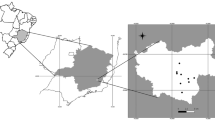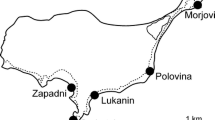Summary
This is a report of lesions associated with the nematode Contracaecum rudolphii (Nematoda: Anisakidae) from the proventriculus of the great cormorant, Phalacrocorax carbo (L. 1758). The study was undertaken as part of a health monitoring program for P. carbo, which is endangered and thus protected within the European continent. Cormorants were collected by gun-shot from north-eastern Poland in the spring of 2006, four birds were necropsied on site and the gastrointestinal tract was examined for the presence of nematodes. The birds came from a region with noted increases in the cormorant population over the last decade. Esophageal and gastric sections with parasites in situ were fixed in formalin and processed routinely for paraffin embedding, stained with H&E and examined by brightfield microscopy. Parasite associated lesions consisted of severe, ulcerative gastritis at the attachment sites, and diffuse granulomatous gastritis in adjacent areas. Eosinophilic material speculated to be the parasite-derived excretory-secretory product was consistently forming the parasite-host boundry at the attachment points. Although the parasite-associated gastric lesions were focally severe, all examined birds appeared in good body condition. Because only four birds were investigated in this study, the potential contribution of C. rudolphii to morbidity and mortality in great cormorants needs to be examined further.
Similar content being viewed by others
References
Abollo, E., Gestal, C., Pascual, S. (2001): Anisakid infection in the European shag Phalacrocorax aristotelis aristotelis. J. Helminthol., 75: 209–214. DOI: 10.1079/JOH200051
Bregnballe, T., Engström, H., Knief, W., van Eerden, M. R., van Rijn, S., Kieckbusch, J. J., Eskilden, J. (2003): Development of the breeding population of Great Cormorants Phalacrocorax carbo sinensis in the Netherlands, Germany, Denmark and Sweden during the 1990. Vogelwelt, 124Suppl.: 15–26
Dirksen, S., Boudewijn, T. J., Slager, L. K., Mes, R. G., van Schaick, M. J. M., de Voogt, P. (1995): B. Reduced breeding success of cormorant (Phalacrocorax carbo sinensis) in relation to persistent organochlorine pollution of aquatic habitats in the Nerherlands. Environ. Pollut., 88: 119–132
Dziekońska-Rynko, J., Rokicki, J., Jabłonowski, Z. (2003): Activity of selected hydrolases in excretion-secretion products and homogenates from L3 and L2 larvae of Anisakis simplex (Nematoda: Anisakidae) parasitizing herring. Acta Ichthyol. Piscat., 33: 125–135
Dziekońska-Rynko, J., Rokicki, J. (2005): Activity of selected hydrolases in excretion-secretion products and extracts of adult Contracaecum rudolphii. Wiad. Parazytol., 51: 227–231
Goc, M. (2006): Cormorants in Europe and Poland: population, legal status, and population control. In Wołos, A. and Niedoszytko, B. (Eds): The Raduńskie Lakes. Anthropogenic influences and protective measures. Wydawnictwo Instytutu Rybactwa Śródlądowego, Olsztyn, pp. 73–96 (in Polish).
Del Hoyo, J., Elliot, A., Sargatal, J. (1992): Handbook of the Birds of the World. Vol. 1. Ostrich to Ducks. Lynx Editions, Barcelona, 696 pp.
Hotez, P. J., Cappello, M., Hawdon, J., Beckers, C., Sakanari, J. (1994): Hyaluronidases of the Gastrointestinal Invasive Nematodes Ancylostoma caninum and Anisakis simplex: Possible Functions in the Pathogenesis of Human Zoonoses. J. Infect. Dis., 170: 918–926
Huizinga, H. W. (1971): Contracaeciasis in pelicanform bird. J. Wildlife Dis., 7: 198–204
Irwin, J. A., Morrissey, P. E. W., Ryan, J. P., Walshe, A., O’Neill, S. M., Carrington, S. D., Matthews, E., Fitzpatrick, E., Muleahy, G., Corfirld, A. P., Dalton, J. P. (2004): Glycosidase activity in the excretory-secretory products of the liver fluke, Fasciola hepatica. Parasitology, 129: 465–472. DOI: 10.1017/S0031182004005803
Kanarek, G., Rolbiecki, L., Sitko, J., Baruš, V., Rokicki, J. (2002): The occurrence of Contracaecum rudolphii Hartwig, 1964 in the cormorant (Phalacrocorax carbo sinensis) in northern Poland. 5. Slovenské a České Parasitologické Dni, Stara Lesna, Slovenska Republika. Program a Zbornik Abstraktov 22. Slovak Society for Parasitology and Czech Society for Parasitology, 68 pp.
Knox, D. P., Kennedy, M. W. (1988): Proteinases released by the parasitic larval stages of Ascaris suum, and their inhibition by antibody. Mol. Biochem. Parasit., 28: 207–216
Kuiken, T., Leighton, F. A., Wobeser, G., Wagner, B. (1999): Causes of morbidity and mortality and their effect on reproductive success in double-crested cormorants from Saskatchewan. J. Wildlife Dis., 35: 331–346
Moczoń, T., Wranicz, M. (1999): Trichinella spiralis: proteinases in the larvae. Parasitol. Res., 85: 47–58.
Morris, S. R., Sakanari, J. A. (1994): Characterization of the serine protease and serine protease inhibitor from the tissue-penetrating nematode Anisakis simplex. J. Biol. Chem., 269: 27650–27656
Nottenkämper, D., Korbel, R., Kösters, J. (1999): The infection of great cormorants (Phalacrocorax carbo sinensis L. 1758) with Contracaecum rudolphii (Nematoda: Ascaridoidea) in the district of Upper Bavaria (Germany) and the canton St. Gallen (Switzerland). Tierärzl. Prax. Kleintier, 4: 27
Opperman, C. H., Chang, S. (1992): Nematode acetylo cholinesterases: molecular forms and their potential role in nematode behavior. Parasitol. Today, 8: 406–411
Owre, O. T. (1962): Nematodes in birds of the Order Peliecaniformes. Auk, 79: 114
Pyrovetsi, M., Papazahariadou, M. (1995): Mortality factors of Dalmatian Pelicans (Pelecanus crispus) wintering in Macedonia, Greece. Environ. Conserv., 22: 345–351
Rhoads, M. L., Fetterer, R. H., Urban, J. F. (1997): Secretion of an aminopeptidase during transition of third- to fourth-stage larvae of Ascaris suum. J. Parasitol, 83: 780–784
Rokicki, J., Piskorzyńska, M., Tokarski, J., Podolska, M. (1993): Hematological and morphological changes in experimental anisakiosis in pigs. Wiad. Parazytol., 39: 155–165
Torres, P., Valdivieso, J., Schlatter, R., Montefusco, A., Revenga, J., Marin, F., Lamilla, J., Ramallo, G. (2000): Infection by Contracaecum rudolphii (Nematoda: Anisakidae) in the Neotropic cormorant Phalacrocorax brasilianus, and fishes from the estuary of the Valdivia river, Chile. Stud. Neotrop. Fauna E., 35: 101–108
Young, P. C., Lowe, D. (1969): Larval nematodes from fish of the subfamily Anisakinae and gastro-intestinal lesions in mammals. J. Comp. Pathol., 79: 301–313
Author information
Authors and Affiliations
Corresponding author
About this article
Cite this article
Rokicki, J., Sołtysiak, Z., Dziekońska-Rynko, J. et al. Pathology associated with Contracaecum rudolphii (Nematoda: Anisakidae) infection in the great cormorant Phalacrocorax carbo (L. 1758). Helminthologia 48, 29–35 (2011). https://doi.org/10.2478/s11687-011-0006-6
Received:
Accepted:
Published:
Issue Date:
DOI: https://doi.org/10.2478/s11687-011-0006-6




